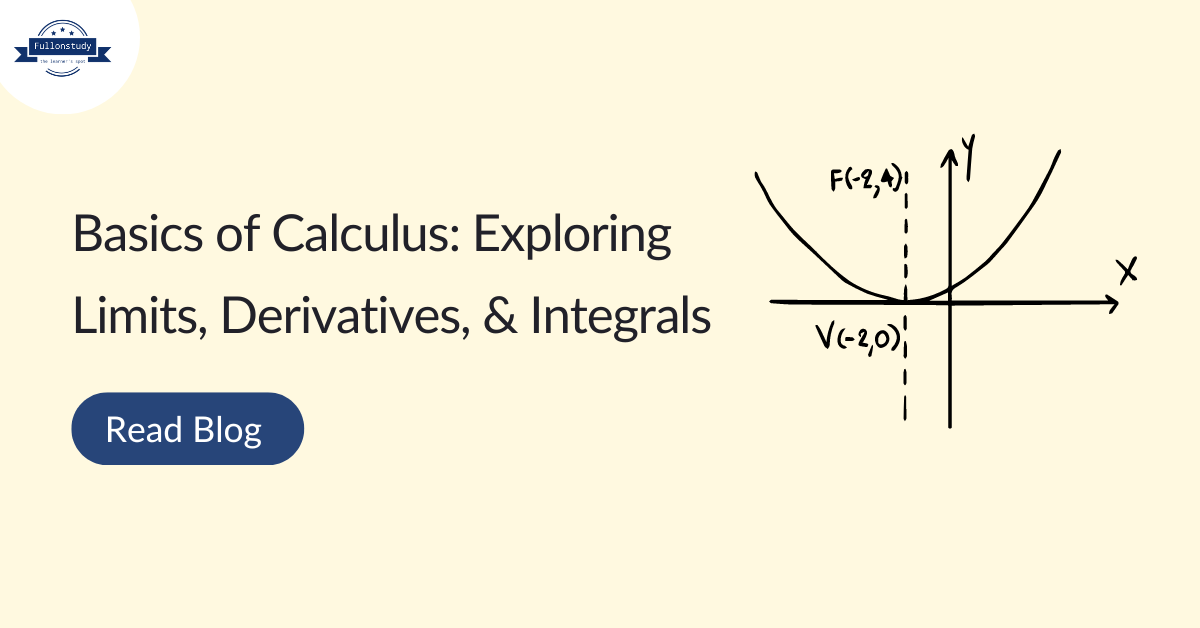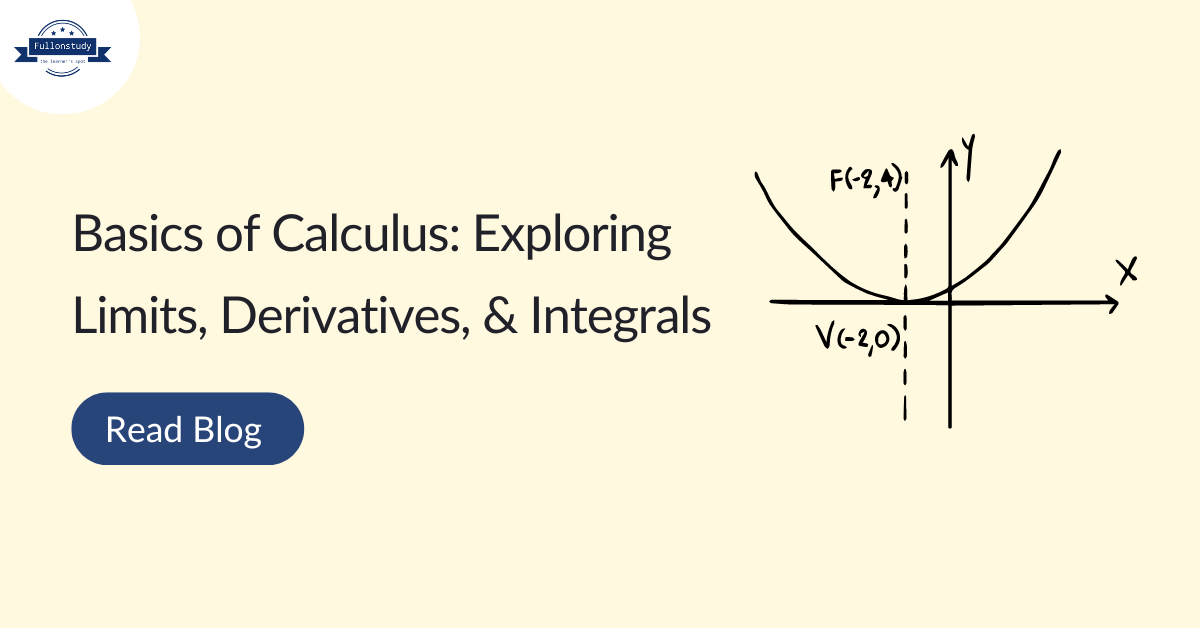Calculus is a fundamental category of mathematics that is also known as the mathematics of change that is essential to deal with change and motion. It is a vast branch of mathematics that is useful in different fields of physics, engineering, and economics.
Calculus deals with the study of properties and behavior of functions. It is used for finding limits, derivatives, and integrals with respect to the variables. In this post, we’ll learn the basics of calculus, its branches, and calculations.
What is Calculus?
In mathematics, calculus is used to find the nature and behavior of the function with respect to the independent variable. It is generally used to deal with the properties and calculations of the limit, derivative, and integral.
It is fundamental for the study of motion, growth, and optimization, and plays a vital role in various fields. The term calculus is a key to problem-solving of various mathematics questions with ease.
There are three basic types of calculus.
- Limit Calculus
- Derivative Calculus
- Integral Calculus

What is Limit Calculus?
Limit is one of the types of calculus that is used to find the numeric value of the function at a particular point. It is generally defined as “A fundamental idea that explains the behavior of the function as the input of that function approaches a specific point is said to be limit in calculus.”
Mathematically. the limit is the function f(y) as “y” approaches the specific point “b” equal to L
| Formula | Components |
| Limy→b f(y) = L | f(y) = The given functiony = The independent variable of the function.b = The particular point of the function (A.K.A limit value)L = The result of the function at a specific point |
Rules of Limit Calculus
Here are a few general rules of limit that are used to solve complex calculus problems related to finding limits.
| Rules of Limit | Explanation | Expression |
| Rule of Addition | This rule of limit calculus is used when a function is given with the addition signs between the terms of that function. | Limy→b [f(y) + h(y)] = Limy→b [f(y)] + Limy→b [h(y)] |
| Rule of Constant | This rule of limit states that the constant function remains unchanged even after applying the limit value. | Limy→b [C] = C |
| Rule of Constant function | This rule will help you to take the constant terms outside the notation of limit calculus. | Limy→b [C *f(y)] = C * Limy→b [f(y)] |
| Rule of Subtraction | This rule of limit calculus is used when a function is given with the subtraction signs between the terms of that function. | Limy→b [f(y) – h(y)] = Limy→b [f(y)] – Limy→b [h(y)] |
| Rule of Multiplication | This rule of limit calculus is used when a function is given with the multiplication signs between the terms of that function. | Limy→b [f(y) x h(y)] = Limy→b [f(y)] x Limy→b [h(y)] |
| Rule of Division | This rule of limit calculus is used when a function is given with the division signs between the terms of that function. | Limy→b [f(y) ÷ h(y)] = Limy→b [f(y)] ÷ Limy→b [h(y)] |
| Rule of Power | The power of the function will be applied after putting the particular point to the function. | Limy→b [fn(y)] = [Limy→b f(y)]n |
| Rule of L’hopital’s | This rule is essential for finding the limit of the function if direct substitution of the limit gives 0/0 or infinity/infinity form | Limy→b [f(y) ÷ h(y)] = Limy→b [f’(y) ÷ h’(y)] |
How to find the Limit of the Function?
The limit of the function can be found easily with the help of rules of limit calculus.
Example
Evaluate the limit of f(y) = (2y3 + 3y – 16) x (2y2 – 5y + 4) if y approaches “2”.
Solution
Step 1: First of all, take the given function and put it inside the notation of the limit.
f(y) = (2y3 + 3y – 16) x (2y2 – 5y + 4)
Limy→b [f(y)] = limy→2 [(2y3 + 3y – 16) x (2y2 – 5y + 4)]
Step 2: Now apply the product rule of limit calculus to the above expression.
limy→2 [(2y3 + 3y – 16) x (2y2 – 5y + 4)] = limy→2 [2y3 + 3y – 16] x limy→2 [2y2 – 5y + 4]
Step 3: Now use the addition and subtraction rules of limit calculus.
limy→2 [(2y3 + 3y – 16) x (2y2 – 5y + 4)] = limy→2 [2y3] + limy→2 [3y] – limy→2 [16] x limy→2 [2y2] – limy→2 [5y] + limy→2 [4]
Step 4: Now take out the constant terms outside the notation of limit.
limy→2 [(2y3 + 3y – 16) x (2y2 – 5y + 4)] = 2limy→2 [y3] + 3limy→2 [y] – limy→2 [16] x 2limy→2 [y2] – 5limy→2 [y] + limy→2 [4]
Step 5: Now put y = 2 in the above expression to find the limit.
limy→2 [(2y3 + 3y – 16) x (2y2 – 5y + 4)] = 2 [23] + 3 [2] – [16] x 2 [22] – 5 [2] + [4]
= (2 [8] + 3 [2] – [16]) x (2 [4] – 5 [2] + [4])
= (16 + 6 – 16) x (8 – 10 + 4)
= (22 – 16) x (-2 + 4)
= (6) x (2)
= 12
You can also try a limit calculator to find the limit of a function with steps to get the result in few seconds.
What is Integral Calculus?
The other type of calculus is integral calculus which is used to find the new function and area under the curve. The process of calculating the integral of the function is said to be integration. It has vast uses and applications in engineering, physics, and economics.
There are further two types of integral calculus i.e., definite and indefinite. The definite integral is used to find the area under the curve with the help of upper and lower limit values. The boundary values are applied to the new function with the help of the fundamental theorem of calculus.
While the other type of integral is used to find the new function without any boundary values. Both types of integral are very essential for various purposes. The formulas for these types of integrals are as follows.
| Formula of | Expression | Components |
| Definite Integral | a∫b f(y) dy = [F(y)]ba = F(b) – F(a) | a & b = the boundary valuesf(y) = differential function F(y) = new function y = integrating variable F(b) – F(a) = fundamental theorem of calculus |
| Indefinite Integral | ∫ f(y) dy = F(y) + C | f(y) = differential function F(y) = new function y = integrating variable C = integrating constant |
Rules of Integral Calculus
Here are a few general rules of integration that are used to solve complex calculus problems related to finding limits.
| Rules of Integral | Expression |
| Rule of Addition | ʃ [f(y) + h(y)] du = ʃ [f(y)] dy – ʃ [h(y)] dy + C |
| Rule of Constant | ʃ k dy = k * y + C |
| Rule of Constant function | ʃ k * f(y) dy = k * ʃ f(y) dy + C |
| Rule of Subtraction | ʃ [f(y) + h(y)] du = ʃ [f(y)] dy – ʃ [h(y)] dy + C |
| Rule of Power | ʃ f(y)n dy = f(y)m + 1/ (m + 1) + C |
How to Find the Integral of the Function?
An antiderivative calculator is a best way to find the integral of a function with steps without performing any calculations. Below is an example of finding integral manually with the help of integration laws.
Example
Evaluate the new function if h(y) = 3y5 – 6y2 + 12y – 4sin(y) + 2y3 with respect to “y”
Solution
Step 1: First of all, take the given function and apply the notation of antiderivative to that function.
h(y) = 3y5 – 6y2 + 12y – 4sin(y) + 2y3
ʃ h(y) dy = ʃ [3y5 – 6y2 + 12y – 4sin(y) + 2y3] dy
Step 2: Now use the addition and subtraction rules of integral calculus to the above expression to apply the integral notation to each term of the function.
ʃ [3y5 – 6y2 + 12y – 4sin(y) + 2y3] dy = ʃ [3y5] dy– ʃ [6y2] dy + ʃ [12y] dy – ʃ [4sin(y)] dy + ʃ [2y3] dy
Step 3: Now take out the constant term outside the notation of integral.
ʃ [3y5 – 6y2 + 12y – 4sin(y) + 2y3] dy = 3ʃ [y5] dy– 6ʃ [y2] dy + 12ʃ [y] dy – 4ʃ [sin(y)] dy + 2ʃ [y3] dy
Step 4: Now integrate the above expression with the help of power and trigonometry properties.
ʃ [3y5 – 6y2 + 12y – 4sin(y) + 2y3] dy = 3 [y5 + 1 / 5 + 1]– 6 [y2 + 1 / 2 + 1] + 12 [y1 + 1 / 1 + 1] – 4 [-cos(y)] + 2 [y3 + 1 / 3 + 1] + C
ʃ [3y5 – 6y2 + 12y – 4sin(y) + 2y3] dy = 3 [y6 / 6]– 6 [y3 / 3] + 12 [y2 / 2] – 4 [-cos(y)] + 2 [y4 / 4] + C
= 3/6 [y6]– 6/3 [y3] + 12/2 [y2] – 4 [-cos(y)] + 2/4 [y4] + C
= 1/2 [y6]– 2/1 [y3] + 6/1 [y2] – 4 [-cos(y)] + 1/2 [y4] + C
= y6/2– 2y3 + 6y2 + 4cos(y) + y4/2 + C
What is Derivative Calculus?
In calculus, derivative (a.k.a differential) is a fundamental branch that deals with the instantaneous rate of change of the function w.r.t to the independent variable of the function. It is frequently used to evaluate the slope of the tangent line.
The differential function could be linear, algebraic, logarithmic, quadric, trigonometric, or polynomial. The derivative of the function gives a brief idea about how the output value of the function changes as we make small adjustments to the input variable.
| Formula | Components |
| f’(y) = Limh→0 [f(h – y) – f(y)]/h | f(y) = The given functiony = The independent variable of the function.Lim = The limit of the functionf’(y) = The differential of the given function |
Rules of Derivative Calculus
Here are a few general rules of derivative that are used to solve complex calculus problems related to finding limits.
| Rules of Limit | Expression |
| Rule of Addition | d/dy [f(y) + h(y)] = d/dy [f(y)] + d/dy [h(y)] |
| Rule of Constant | d/dy [k] = 0 Or f’(k) = 0 |
| Rule of Constant function | d/dy [k f(y)] = k d/dy [f(y)] |
| Rule of Subtraction | d/dy [f(y) – h(y)] = d/dy [f(y)] – d/dy [h(y)] |
| Rule of Multiplication | d/dx [f(x) / h(x)] = 1/[h(x)]2 [h(x) d/dx [f(x)] – f(x) d/dy [h(x)]] |
| Rule of Division | d/dx [f(x) / h(x)] = h(y) d/dy [f(y)] + f(y) d/dy [h(y)] |
| Rule of Power | d/dy [fn(y)] = n f(y)n – 1 |
Try a differentiation calculator to find the derivative of the given function according to the above discussed rules.
How to Find the Derivative of the Function?
The derivative of the function can be found easily with the help of the rules of derivative calculus.
Example
Evaluate the differential of h(y) = 6y3 – 12y2 + 4sin(y) + (y * 4y4) with respect to “y”.
Solution
Step 1: First of all, take the given function and write the notation of the derivative to it.
d/dy [h(y)] = d/dy [6y3 – 12y2 + 4sin(y) + (y * 4y4)]
Step 2: Now use the addition and subtraction rules of derivative calculus to the above expression to apply the derivative notation to each term of the function.
d/dy [6y3 – 12y2 + 4sin(y) + 5(y * 4y4)] = d/dy [6y3] – d/dy [12y2] + d/dy [4sin(y)] + d/dy [(y * 4y4)]
Step 3: Now apply the product rule to the above expression
d/dy [6y3 – 12y2 + 4sin(y) + 5(y * 4y4)] = d/dy [6y3] – d/dy [12y2] + d/dy [4sin(y)] + [(4y4d/dy (y) + y d/dy (4y4)]
d/dy [6y3 – 12y2 + 4sin(y) + 5(y * 4y4)] = d/dy [6y3] – d/dy [12y2] + d/dy [4sin(y)] + 4y4d/dy (y) + y d/dy (4y4)
Step 4: Now take the constant coefficient outside the notation.
d/dy [6y3 – 12y2 + 4sin(y) + 5(y * 4y4)] = 6d/dy [y3] – 12d/dy [y2] + 4d/dy [sin(y)] + 4y4d/dy [y] + 4y d/dy [4y4]
Step 4: Now use the power rule to differentiate the above expression.
d/dy [6y3 – 12y2 + 4sin(y) + 5(y * 4y4)] = 6 [3 y3-1] – 12 [2 y2-1] + 4 [cos(y)] + 4y4 [y1-1] + 4y [16 y4-1]
= 6 [3 y2] – 12 [2 y1] + 4 [cos(y)] + 4y4 [y0] + 4y [16 y3]
= 6 [3 y2] – 12 [2 y] + 4 [cos(y)] + 4y4 [1] + 4y [16 y3]
= 18 y2 – 24y + 4cos(y) + 4y4 + 64y4
= 18 y2 – 24y + 4cos(y) + 68y4
Wrap Up
Now you can get all the information about the basics of calculus and its types from this post. We have discussed the limit, derivative, and integral with their definitions, formulas, rules, and solved examples.
Related: BSc Physics Books FREE Download PDF
About the Author(s):
Fullonstudy Team is a passionate team of educators, content creators, and students, committed to bringing you reliable, up-to-date, and accessible study resources. With a blend of academic knowledge, teaching experience, and a focus on simplifying complex topics, we are here to help guide you through your educational journey.
Other key team members who influence the content you read on our website include those in charge of research, content writing, editing, curriculum design, website development, and user experience. We also collaborate with experts in various academic fields to ensure the accuracy and relevance of our resources.





